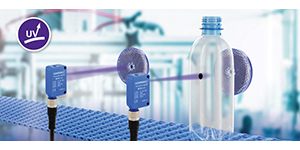Reliable detection of transparent objects; Photoelectric sensor uses UV light
 When it comes to detecting transparent objects, the limits of conventional photoelectric sensors are soon apparent. Since clear glass or plastic absorb only a small amount of light, there is little difference between emitted and received light levels. As a result, switching signals may be unclear. Contamination by dust or moisture on the lens – unavoidable in many areas of application – can lead to counting errors. Until now, such problems have been mitigated through the use of complex algorithms in the controller or by constant fine adjustment. A new approach offers a solution.
When it comes to detecting transparent objects, the limits of conventional photoelectric sensors are soon apparent. Since clear glass or plastic absorb only a small amount of light, there is little difference between emitted and received light levels. As a result, switching signals may be unclear. Contamination by dust or moisture on the lens – unavoidable in many areas of application – can lead to counting errors. Until now, such problems have been mitigated through the use of complex algorithms in the controller or by constant fine adjustment. A new approach offers a solution.
The Contrinex TRU-C23 photoelectric sensor is ideally suited for the presence control of transparent objects. Its technology uses UV light. Since transparent materials like plastic or glass absorb large amounts of polarized UV light, it is very easy to set the threshold at which the sensor switches. This makes commissioning much easier. The shape or thickness of the target has no influence on detection. In addition, sensor performance is unaffected by dirt, water drops or aging. Multiple switching for the same object is eliminated.
The sensor system comprises an LED that emits polarized UV light and a reflector made of special materials suitable for UV. Overall, the sensor’s operating range is around 1000 mm. Special optics with autocollimation ensure reliable detection and no blind zone, even close to the sensor or through a small notch. The housing, which is only 30 x 20 x 10 mm, is compatible with the entire C23 series as well as comparable devices. The IO-Link interface also provides the important additional benefit of remote commissioning, diagnostics and parameterization as standard and at no extra cost. The sensor is Ecolab tested and approved, rated to IP67 and reliably withstands common industrial cleaning processes.
Versatile family
For applications requiring the detection of thicker or larger transparent objects, the C23 Transparent Standard can be the ideal solution. It operates with polarized, red light and has a maximum operating range up to 2500 mm. This new sensor provides a highly favorable price-performance ratio. The entire C23 family of photoelectric sensors, which offers solutions for a wide variety of applications, can also be viewed at this exhibition. Typical fields of application for the two newest members of the family can be found in the food, pharmaceutical and packaging industries, for example when filling glass or plastic bottles, packing in plastic or when the detection of clear packaging film is required.


